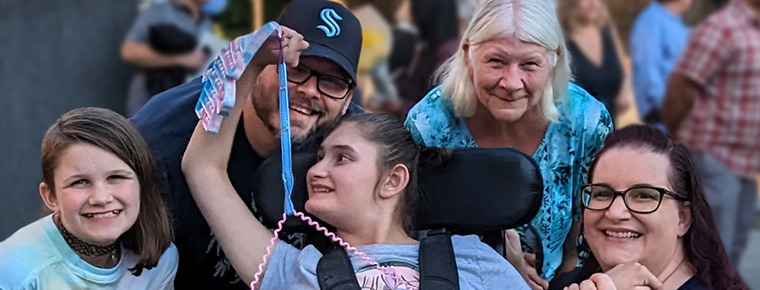
The Cost and Benefits of Caregiving
Becoming a caregiver for a family member or friend can come with challenges and joys. Learn about the financial challenges caregivers face and resources that can help.
Amanda realized something was unusual when her infant daughter, Aishlyn, began missing developmental milestones. Genetic testing revealed that Aishlyn had an extremely rare deletion on her 22nd chromosome. This deletion can lead to a variety of physical and mental development issues. For Aishlyn, it meant more complications than for many others.
Today, 14-year-old Aishlyn can choose between two toys and respond yes or no by tilting her head to the right (for yes) or left (for no). Non-ambulatory due to a lack of muscle tone, Aishlyn uses a wheelchair and is fed through a tube. She's among the 70% of Washington state residents who currently or will eventually need long-term services and help with activities of daily living, like bathing, eating and taking medications.
"The only thing that's been normal over the past 14 years is that doctors and our family are learning things together," says Amanda W., an IT Senior Business Systems Analyst for BECU.
For many people like Amanda, becoming a caregiver brought challenges — and joys. In addition to learning how to care for Aishlyn and how to navigate complex medical systems, Amanda and her husband had to figure out how to manage family finances to cover the costs of care.
What Is a Caregiver?
Caregivers help spouses, partners, children and parents experiencing long-term physical conditions, emotional or mental health issues and memory problems, including dementia or Alzheimer's disease.
Caregivers assist with transportation, grocery or other shopping, housework, meal prep and daily-living needs such as getting out of bed, getting up from a chair, getting dressed, feeding and bathing. They may also closely monitor their care recipient's condition, communicate with health care providers and advocate for their recipient.
This care provided by unpaid family and friends was valued at an estimated $600 billion in 2021, according to an AARP report.
The emotional toll can be significant, particularly as caregiving needs increase. Caregivers are more likely to say they're in worse health and often report feeling loneliness, physical strain and emotional stress.
The Financial Strain of Caregiving
Early on, Amanda and her husband realized that specialized care for their daughter would cost the same amount as one parent's income. "Financially, emotionally, logistically, it didn't make sense," she said. The couple decided her husband would become a full-time, at-home caregiver while she returned to work.
But as an at-home caregiver, her husband was unpaid. Losing half of the family's income took a severe financial toll. The couple rapidly depleted savings to pay more than $500,000 in medical debt after insurance paid its portion. They moved out of their house, unable to afford the house payment.
Around 38 million people in the U.S. are unpaid family caregivers, according to a 2021 report from the AARP Public Policy Institute (PDF).
Most caregivers pay routine care expenses out-of-pocket. These expenses include meals, services, medical supplies and other costs. The average caregiver's annual out-of-pocket costs add up to $7,200, and almost $9,000 annually for caregivers of someone with dementia.
The report notes that almost half of caregivers report at least one financial impact, which can include:
- Using up short-term or long-term savings.
- Leaving bills unpaid or delaying bill payment.
- Borrowing money from family and friends.
- Inability to afford basic expenses like food.
- Moving to a less expensive home, apartment or other living arrangement.
- Delaying retirement or deciding never to retire.
Many of these financial challenges lead to longer-term impacts, such as decreased retirement savings, more debt and even bankruptcies. These financial challenges can put future financial security at risk if the caregiving situation lasts a long time.
After careful consideration and consulting with a bankruptcy lawyer, Amanda and her husband filed for bankruptcy and planned for post-bankruptcy life.
"We knew it was the best thing for us going forward," Amanda said.
Their lawyer reviewed bank accounts and debts, made sure the couple understood bankruptcy's implications and discussed their plans for budgeting and rebuilding credit after bankruptcy.
Working While Caregiving
According to the AARP survey, most caregivers work full-time while providing care and dealing with the stress of work-related impacts. Working as a caregiver often requires going in late or leaving early, taking time off to accommodate caregiving responsibilities, giving up work entirely or retiring early.
To qualify for government assistance, families often have to meet income requirements. If they earn more than the qualifying amount, they often won't get any help, even if the amount they earn doesn't cover their expenses.
At age 9, Aishlyn finally qualified for state-based Medicaid, which assists with medical costs not covered by insurance. The process required paperwork, documentation and massive amounts of patience.
Qualifying for long-term disability through Medicaid made a major financial difference. With the designation, the family received financial assistance for medical care and a case manager could provide information and resources and answer questions about services and equipment.
When Aishlyn qualified for Medicaid, the financial formula also shifted away from parental income. As long as Aishlyn doesn't have more than $2,000 in a bank account, she can receive services.
"Now that my income isn't a factor, I've been able to grow in my career, take a higher position that benefits us, and make more money now. We're not rich, but things are a lot easier," Amanda says. "We are comfortable and can afford a home, care for our daughter, and put a little bit into my 401(k)."
Financially Preparing for Care
According to the NAP/AARP report, only half of caregivers report that their care recipient has plans for future care, such as handling financial matters or living arrangements. Notably, Medicaid may not be able to help until the care recipient spends savings down to $2,000.
Caregivers may need to rely on retirement or pension funds, a reverse mortgage, or a costly, private long-term care insurance plan. According to the American Association for Long-Term Insurance, a plan cost for a couple, age 55, can range between $5,018 to $14,695 annually for $165,000 in insurance, growing at 3% compounded annually.
Starting in July 2023, Washington state will attempt to address this issue. Washington residents will automatically contribute 0.58% of every paycheck to the new WA Cares Fund (unless they received an exemption). After contributing for 10 years, eligible Washington residents can access long-term care services and support of up to $36,500 per person. You can use funds to pay a qualified family member (including a spouse) for care. But, considering the potentially high costs of providing care, many caregivers won't be able to rely solely on the WA Cares Fund.
Care Provider Pay and Support
In some states, spouses and other family members get paid to provide care. But in Washington, other than the WA Cares Fund, the state generally only helps pay for a non-spouse family member to become a caregiver.
Generally, the care recipient must live at home, be eligible for care services and receive Medicaid. You can learn more about the program by visiting the Consumer Direct Care Network site.
Several programs offer services and support to unpaid caregivers. Depending on the program, unpaid caregivers could qualify for free or low-cost caregiver support groups and counseling, training and in-home services. Washington State Department of Social and Health Services helps facilitate these caregiver support and resources.
Washington Connection can provide information on applying for various services for people who are 65 or older, blind or disabled. The site also contains links to financial resources, including emergency financial assistance.
The maze of state and federal programs can be confusing. Sometimes, it's best to pick up the phone and call an agency or talk with people in your network about their experiences.
Arc of Washington State provides many free services and resources to caregivers. Arc's peer network links caregivers with others in a similar situation. Amanda and her family have relied on Arc's services. "We often felt isolated and like nobody understood," Amanda said. "Connecting with others and being part of that community has been so emotionally helpful."
By meeting with professionals, you can map out your future. Amanda's upcoming tasks include estate planning to ensure Aishlyn keeps her financial support. She also needs to ensure family and friends don't give Aishlyn too much money for a savings account. Her parents take on the financial and tax liabilities for gifts intended for their daughter.
Rewards of Caregiving
Although the challenges can be many, there are positive aspects to being a caregiver, too. According to the CDC, caregivers report that caregiving provides a sense of purpose. The work can boost self-confidence, increase a sense of fulfillment and start or add to social networks.
For the recipients, benefits include retaining independence and quality of life, avoiding living in an institutional care facility, potentially experiencing less depression and improving chronic condition self-management.
The experience has been meaningful for Amanda: "Communication has been a gigantic challenge, to learn Aishlyn's cues when she's upset and we don't know why. Maybe she's hungry, or it's something else," Amanda said. "But being able to witness her growth has been rewarding."
"I now know what unconditional love means," Amanda said. "When you have a teen that's so happy to see you when you walk into a room, and they smile or laugh, it wipes any emotional stress away. That is everything to us."

